How Business Operates: Accounting, HR, Team Development, Leadership
VerifiedAdded on 2020/12/10
|15
|4028
|182
Report
AI Summary
This report analyzes various aspects of business operations, using Marks & Spencer as a case study. It begins with an introduction to business operations, highlighting the significance of accounting in providing financial information to stakeholders and its role in decision-making. The report then delves into human resources, outlining the key functions of an HR department, including hiring, training, compensation, employee benefits, employee relations, and legal responsibilities. Furthermore, it explains the key features of employment legislation. The report also interprets information from a profit and loss account, providing calculations and insights into the company's financial performance. It explores the stages of team development, based on Tuckman's model, and analyzes different team roles according to Belbin's theory. The report discusses motivation theories and different types of leadership styles, providing a comprehensive understanding of how businesses operate. Finally, the report covers customer service and customer profiling.
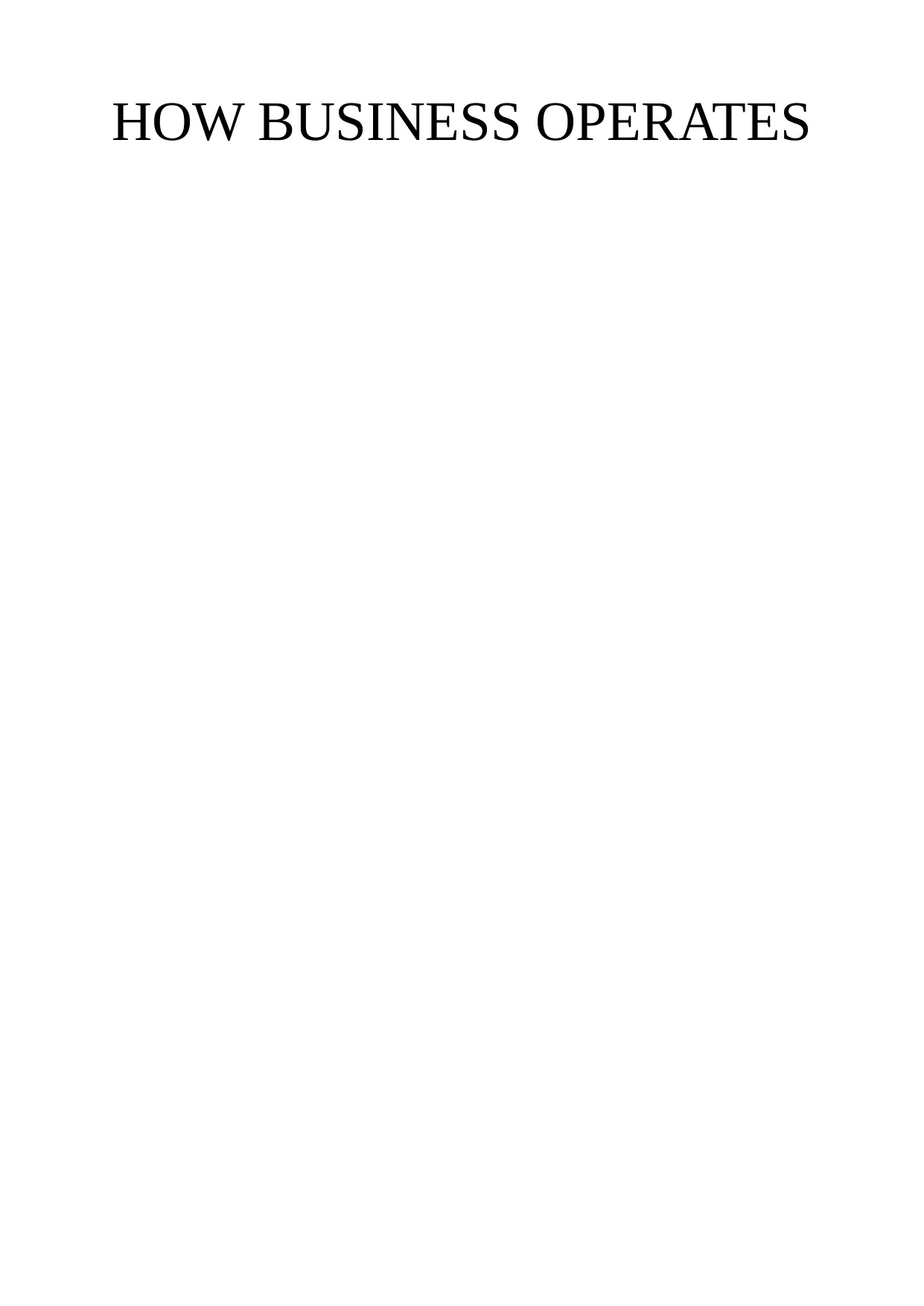
HOW BUSINESS OPERATES
Paraphrase This Document
Need a fresh take? Get an instant paraphrase of this document with our AI Paraphraser
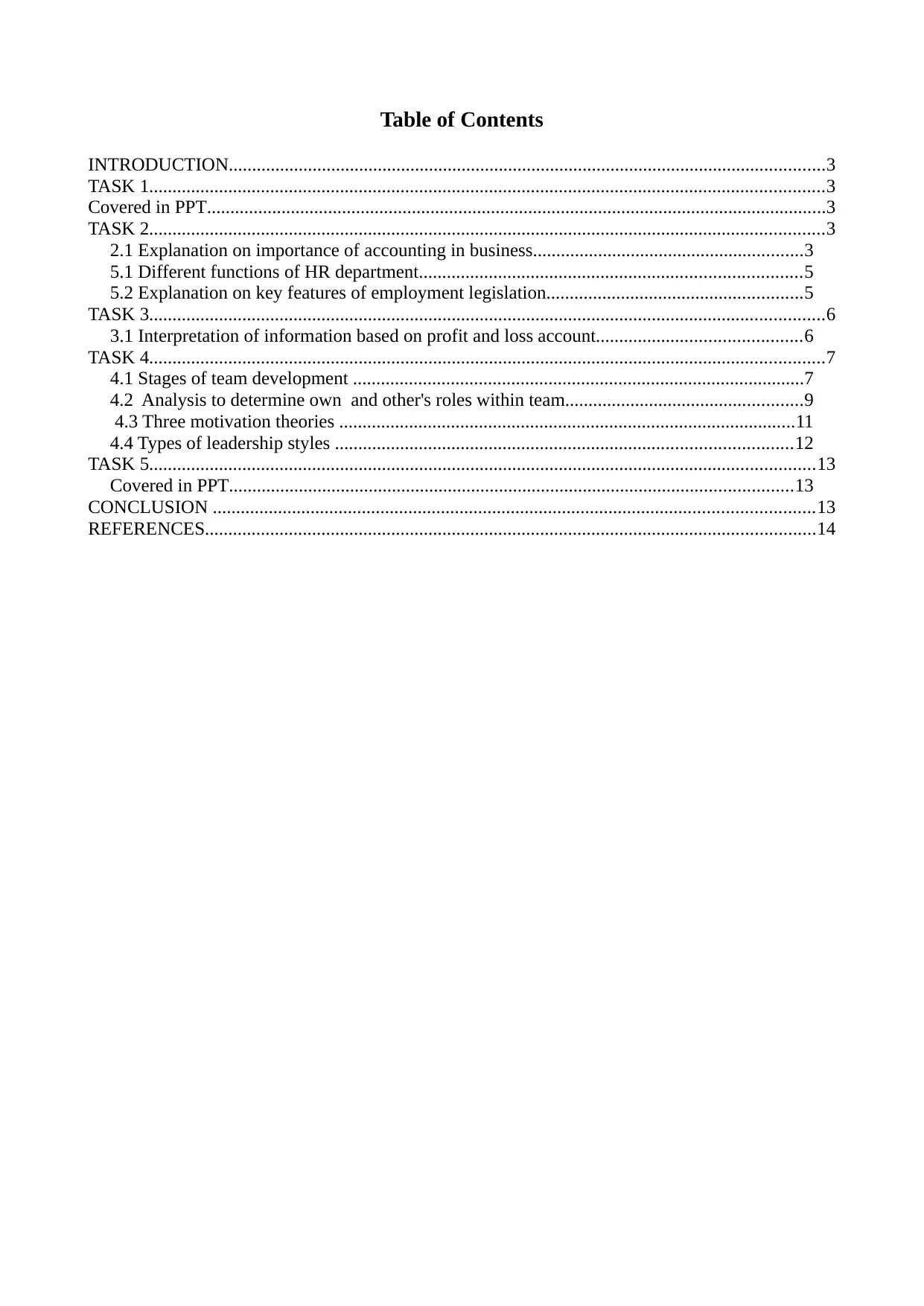
Table of Contents
INTRODUCTION................................................................................................................................3
TASK 1.................................................................................................................................................3
Covered in PPT.....................................................................................................................................3
TASK 2.................................................................................................................................................3
2.1 Explanation on importance of accounting in business..........................................................3
5.1 Different functions of HR department..................................................................................5
5.2 Explanation on key features of employment legislation.......................................................5
TASK 3.................................................................................................................................................6
3.1 Interpretation of information based on profit and loss account............................................6
TASK 4.................................................................................................................................................7
4.1 Stages of team development .................................................................................................7
4.2 Analysis to determine own and other's roles within team...................................................9
4.3 Three motivation theories ..................................................................................................11
4.4 Types of leadership styles ..................................................................................................12
TASK 5...............................................................................................................................................13
Covered in PPT.........................................................................................................................13
CONCLUSION .................................................................................................................................13
REFERENCES...................................................................................................................................14
INTRODUCTION................................................................................................................................3
TASK 1.................................................................................................................................................3
Covered in PPT.....................................................................................................................................3
TASK 2.................................................................................................................................................3
2.1 Explanation on importance of accounting in business..........................................................3
5.1 Different functions of HR department..................................................................................5
5.2 Explanation on key features of employment legislation.......................................................5
TASK 3.................................................................................................................................................6
3.1 Interpretation of information based on profit and loss account............................................6
TASK 4.................................................................................................................................................7
4.1 Stages of team development .................................................................................................7
4.2 Analysis to determine own and other's roles within team...................................................9
4.3 Three motivation theories ..................................................................................................11
4.4 Types of leadership styles ..................................................................................................12
TASK 5...............................................................................................................................................13
Covered in PPT.........................................................................................................................13
CONCLUSION .................................................................................................................................13
REFERENCES...................................................................................................................................14
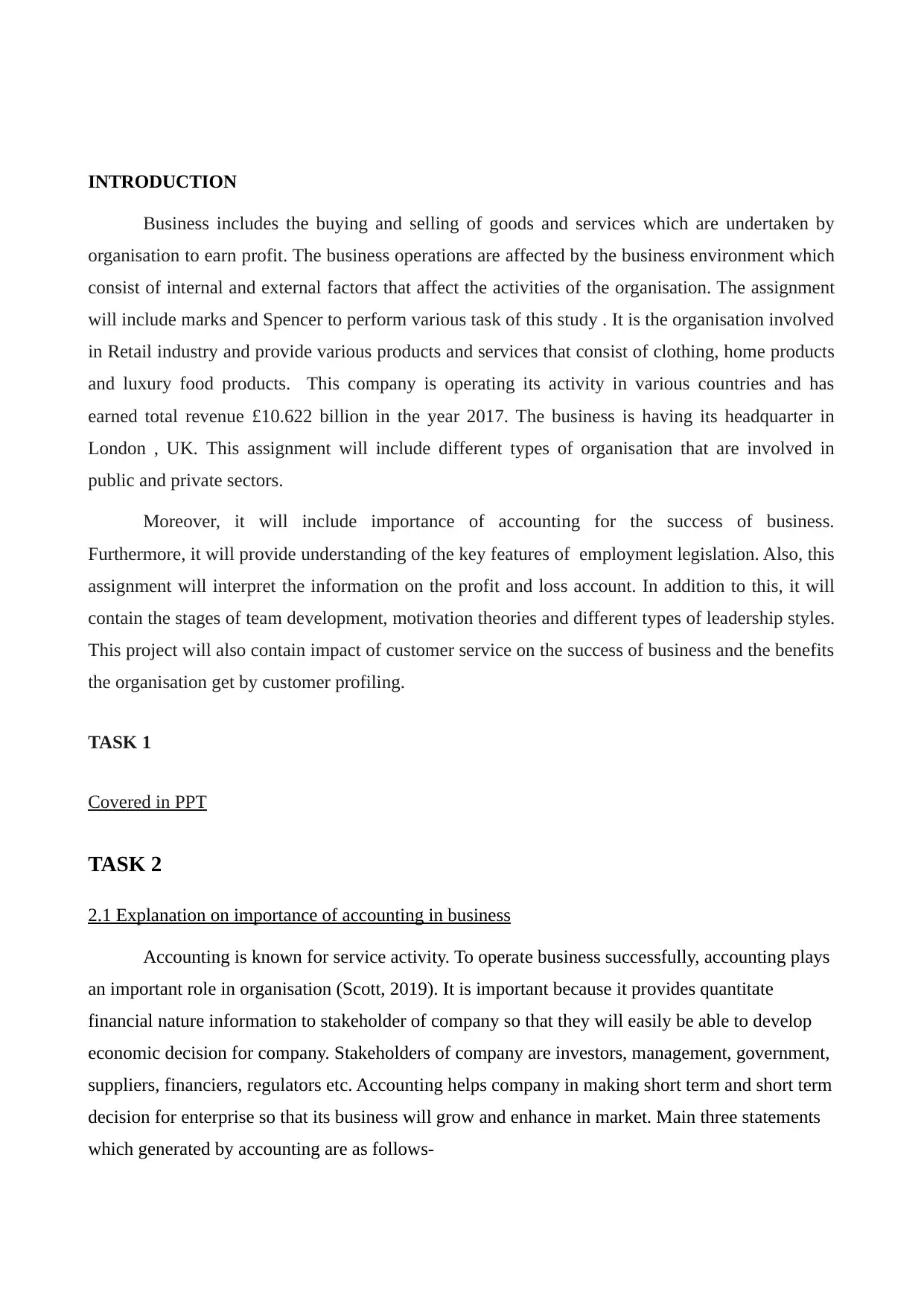
INTRODUCTION
Business includes the buying and selling of goods and services which are undertaken by
organisation to earn profit. The business operations are affected by the business environment which
consist of internal and external factors that affect the activities of the organisation. The assignment
will include marks and Spencer to perform various task of this study . It is the organisation involved
in Retail industry and provide various products and services that consist of clothing, home products
and luxury food products. This company is operating its activity in various countries and has
earned total revenue £10.622 billion in the year 2017. The business is having its headquarter in
London , UK. This assignment will include different types of organisation that are involved in
public and private sectors.
Moreover, it will include importance of accounting for the success of business.
Furthermore, it will provide understanding of the key features of employment legislation. Also, this
assignment will interpret the information on the profit and loss account. In addition to this, it will
contain the stages of team development, motivation theories and different types of leadership styles.
This project will also contain impact of customer service on the success of business and the benefits
the organisation get by customer profiling.
TASK 1
Covered in PPT
TASK 2
2.1 Explanation on importance of accounting in business
Accounting is known for service activity. To operate business successfully, accounting plays
an important role in organisation (Scott, 2019). It is important because it provides quantitate
financial nature information to stakeholder of company so that they will easily be able to develop
economic decision for company. Stakeholders of company are investors, management, government,
suppliers, financiers, regulators etc. Accounting helps company in making short term and short term
decision for enterprise so that its business will grow and enhance in market. Main three statements
which generated by accounting are as follows-
Business includes the buying and selling of goods and services which are undertaken by
organisation to earn profit. The business operations are affected by the business environment which
consist of internal and external factors that affect the activities of the organisation. The assignment
will include marks and Spencer to perform various task of this study . It is the organisation involved
in Retail industry and provide various products and services that consist of clothing, home products
and luxury food products. This company is operating its activity in various countries and has
earned total revenue £10.622 billion in the year 2017. The business is having its headquarter in
London , UK. This assignment will include different types of organisation that are involved in
public and private sectors.
Moreover, it will include importance of accounting for the success of business.
Furthermore, it will provide understanding of the key features of employment legislation. Also, this
assignment will interpret the information on the profit and loss account. In addition to this, it will
contain the stages of team development, motivation theories and different types of leadership styles.
This project will also contain impact of customer service on the success of business and the benefits
the organisation get by customer profiling.
TASK 1
Covered in PPT
TASK 2
2.1 Explanation on importance of accounting in business
Accounting is known for service activity. To operate business successfully, accounting plays
an important role in organisation (Scott, 2019). It is important because it provides quantitate
financial nature information to stakeholder of company so that they will easily be able to develop
economic decision for company. Stakeholders of company are investors, management, government,
suppliers, financiers, regulators etc. Accounting helps company in making short term and short term
decision for enterprise so that its business will grow and enhance in market. Main three statements
which generated by accounting are as follows-
⊘ This is a preview!⊘
Do you want full access?
Subscribe today to unlock all pages.

Trusted by 1+ million students worldwide
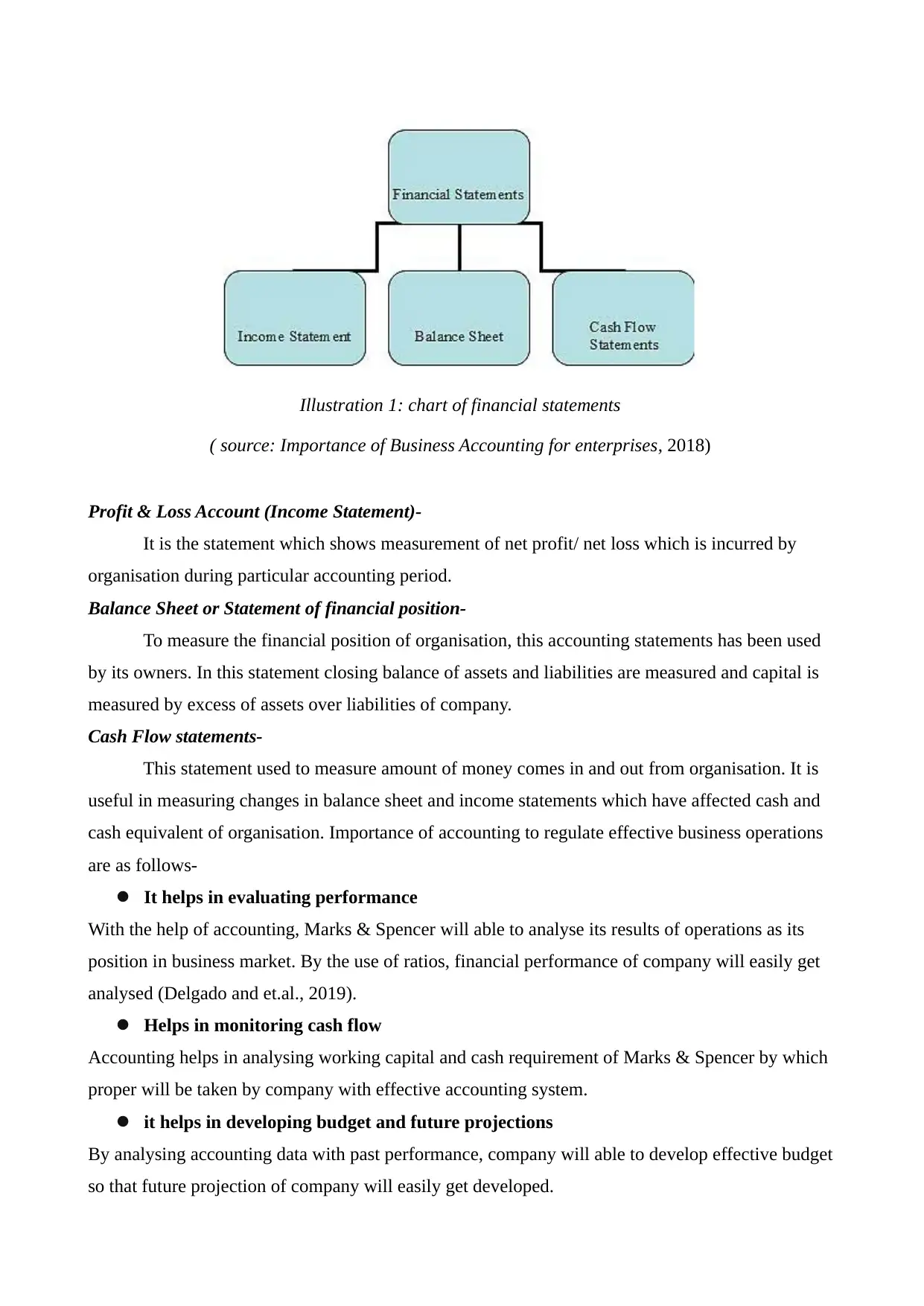
Profit & Loss Account (Income Statement)-
It is the statement which shows measurement of net profit/ net loss which is incurred by
organisation during particular accounting period.
Balance Sheet or Statement of financial position-
To measure the financial position of organisation, this accounting statements has been used
by its owners. In this statement closing balance of assets and liabilities are measured and capital is
measured by excess of assets over liabilities of company.
Cash Flow statements-
This statement used to measure amount of money comes in and out from organisation. It is
useful in measuring changes in balance sheet and income statements which have affected cash and
cash equivalent of organisation. Importance of accounting to regulate effective business operations
are as follows-
It helps in evaluating performance
With the help of accounting, Marks & Spencer will able to analyse its results of operations as its
position in business market. By the use of ratios, financial performance of company will easily get
analysed (Delgado and et.al., 2019).
Helps in monitoring cash flow
Accounting helps in analysing working capital and cash requirement of Marks & Spencer by which
proper will be taken by company with effective accounting system.
it helps in developing budget and future projections
By analysing accounting data with past performance, company will able to develop effective budget
so that future projection of company will easily get developed.
Illustration 1: chart of financial statements
( source: Importance of Business Accounting for enterprises, 2018)
It is the statement which shows measurement of net profit/ net loss which is incurred by
organisation during particular accounting period.
Balance Sheet or Statement of financial position-
To measure the financial position of organisation, this accounting statements has been used
by its owners. In this statement closing balance of assets and liabilities are measured and capital is
measured by excess of assets over liabilities of company.
Cash Flow statements-
This statement used to measure amount of money comes in and out from organisation. It is
useful in measuring changes in balance sheet and income statements which have affected cash and
cash equivalent of organisation. Importance of accounting to regulate effective business operations
are as follows-
It helps in evaluating performance
With the help of accounting, Marks & Spencer will able to analyse its results of operations as its
position in business market. By the use of ratios, financial performance of company will easily get
analysed (Delgado and et.al., 2019).
Helps in monitoring cash flow
Accounting helps in analysing working capital and cash requirement of Marks & Spencer by which
proper will be taken by company with effective accounting system.
it helps in developing budget and future projections
By analysing accounting data with past performance, company will able to develop effective budget
so that future projection of company will easily get developed.
Illustration 1: chart of financial statements
( source: Importance of Business Accounting for enterprises, 2018)
Paraphrase This Document
Need a fresh take? Get an instant paraphrase of this document with our AI Paraphraser
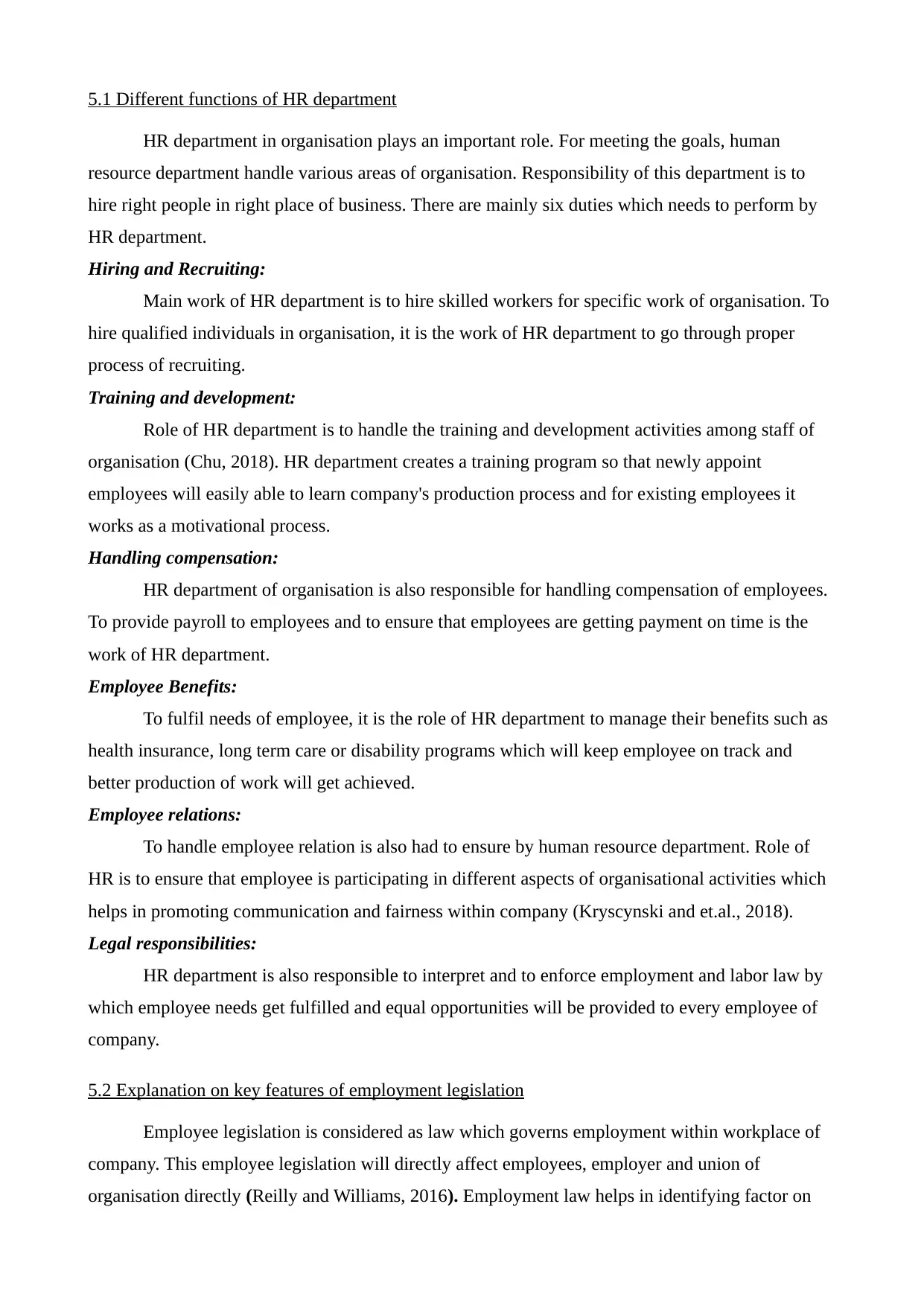
5.1 Different functions of HR department
HR department in organisation plays an important role. For meeting the goals, human
resource department handle various areas of organisation. Responsibility of this department is to
hire right people in right place of business. There are mainly six duties which needs to perform by
HR department.
Hiring and Recruiting:
Main work of HR department is to hire skilled workers for specific work of organisation. To
hire qualified individuals in organisation, it is the work of HR department to go through proper
process of recruiting.
Training and development:
Role of HR department is to handle the training and development activities among staff of
organisation (Chu, 2018). HR department creates a training program so that newly appoint
employees will easily able to learn company's production process and for existing employees it
works as a motivational process.
Handling compensation:
HR department of organisation is also responsible for handling compensation of employees.
To provide payroll to employees and to ensure that employees are getting payment on time is the
work of HR department.
Employee Benefits:
To fulfil needs of employee, it is the role of HR department to manage their benefits such as
health insurance, long term care or disability programs which will keep employee on track and
better production of work will get achieved.
Employee relations:
To handle employee relation is also had to ensure by human resource department. Role of
HR is to ensure that employee is participating in different aspects of organisational activities which
helps in promoting communication and fairness within company (Kryscynski and et.al., 2018).
Legal responsibilities:
HR department is also responsible to interpret and to enforce employment and labor law by
which employee needs get fulfilled and equal opportunities will be provided to every employee of
company.
5.2 Explanation on key features of employment legislation
Employee legislation is considered as law which governs employment within workplace of
company. This employee legislation will directly affect employees, employer and union of
organisation directly (Reilly and Williams, 2016). Employment law helps in identifying factor on
HR department in organisation plays an important role. For meeting the goals, human
resource department handle various areas of organisation. Responsibility of this department is to
hire right people in right place of business. There are mainly six duties which needs to perform by
HR department.
Hiring and Recruiting:
Main work of HR department is to hire skilled workers for specific work of organisation. To
hire qualified individuals in organisation, it is the work of HR department to go through proper
process of recruiting.
Training and development:
Role of HR department is to handle the training and development activities among staff of
organisation (Chu, 2018). HR department creates a training program so that newly appoint
employees will easily able to learn company's production process and for existing employees it
works as a motivational process.
Handling compensation:
HR department of organisation is also responsible for handling compensation of employees.
To provide payroll to employees and to ensure that employees are getting payment on time is the
work of HR department.
Employee Benefits:
To fulfil needs of employee, it is the role of HR department to manage their benefits such as
health insurance, long term care or disability programs which will keep employee on track and
better production of work will get achieved.
Employee relations:
To handle employee relation is also had to ensure by human resource department. Role of
HR is to ensure that employee is participating in different aspects of organisational activities which
helps in promoting communication and fairness within company (Kryscynski and et.al., 2018).
Legal responsibilities:
HR department is also responsible to interpret and to enforce employment and labor law by
which employee needs get fulfilled and equal opportunities will be provided to every employee of
company.
5.2 Explanation on key features of employment legislation
Employee legislation is considered as law which governs employment within workplace of
company. This employee legislation will directly affect employees, employer and union of
organisation directly (Reilly and Williams, 2016). Employment law helps in identifying factor on
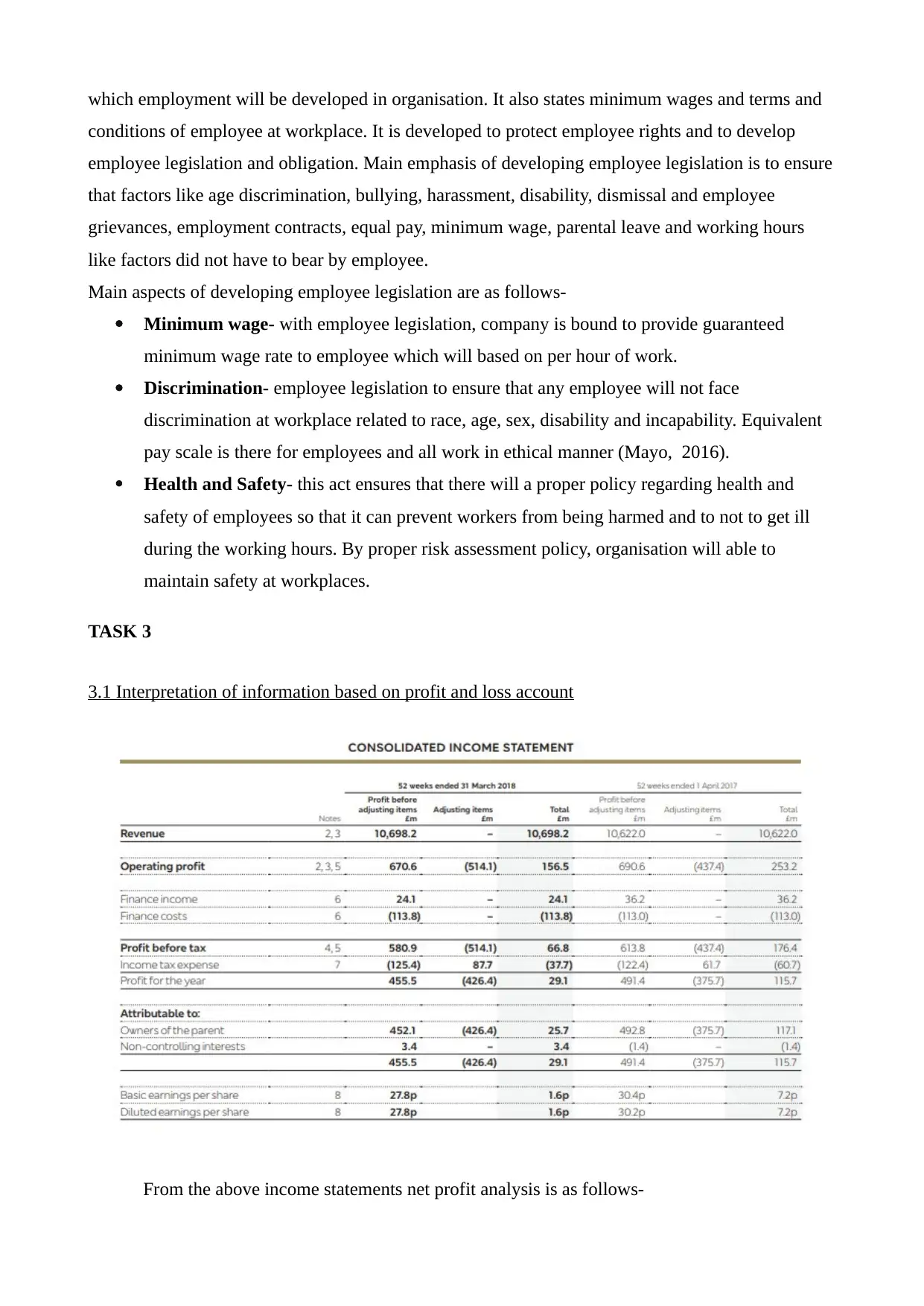
which employment will be developed in organisation. It also states minimum wages and terms and
conditions of employee at workplace. It is developed to protect employee rights and to develop
employee legislation and obligation. Main emphasis of developing employee legislation is to ensure
that factors like age discrimination, bullying, harassment, disability, dismissal and employee
grievances, employment contracts, equal pay, minimum wage, parental leave and working hours
like factors did not have to bear by employee.
Main aspects of developing employee legislation are as follows-
Minimum wage- with employee legislation, company is bound to provide guaranteed
minimum wage rate to employee which will based on per hour of work.
Discrimination- employee legislation to ensure that any employee will not face
discrimination at workplace related to race, age, sex, disability and incapability. Equivalent
pay scale is there for employees and all work in ethical manner (Mayo, 2016).
Health and Safety- this act ensures that there will a proper policy regarding health and
safety of employees so that it can prevent workers from being harmed and to not to get ill
during the working hours. By proper risk assessment policy, organisation will able to
maintain safety at workplaces.
TASK 3
3.1 Interpretation of information based on profit and loss account
From the above income statements net profit analysis is as follows-
conditions of employee at workplace. It is developed to protect employee rights and to develop
employee legislation and obligation. Main emphasis of developing employee legislation is to ensure
that factors like age discrimination, bullying, harassment, disability, dismissal and employee
grievances, employment contracts, equal pay, minimum wage, parental leave and working hours
like factors did not have to bear by employee.
Main aspects of developing employee legislation are as follows-
Minimum wage- with employee legislation, company is bound to provide guaranteed
minimum wage rate to employee which will based on per hour of work.
Discrimination- employee legislation to ensure that any employee will not face
discrimination at workplace related to race, age, sex, disability and incapability. Equivalent
pay scale is there for employees and all work in ethical manner (Mayo, 2016).
Health and Safety- this act ensures that there will a proper policy regarding health and
safety of employees so that it can prevent workers from being harmed and to not to get ill
during the working hours. By proper risk assessment policy, organisation will able to
maintain safety at workplaces.
TASK 3
3.1 Interpretation of information based on profit and loss account
From the above income statements net profit analysis is as follows-
⊘ This is a preview!⊘
Do you want full access?
Subscribe today to unlock all pages.

Trusted by 1+ million students worldwide
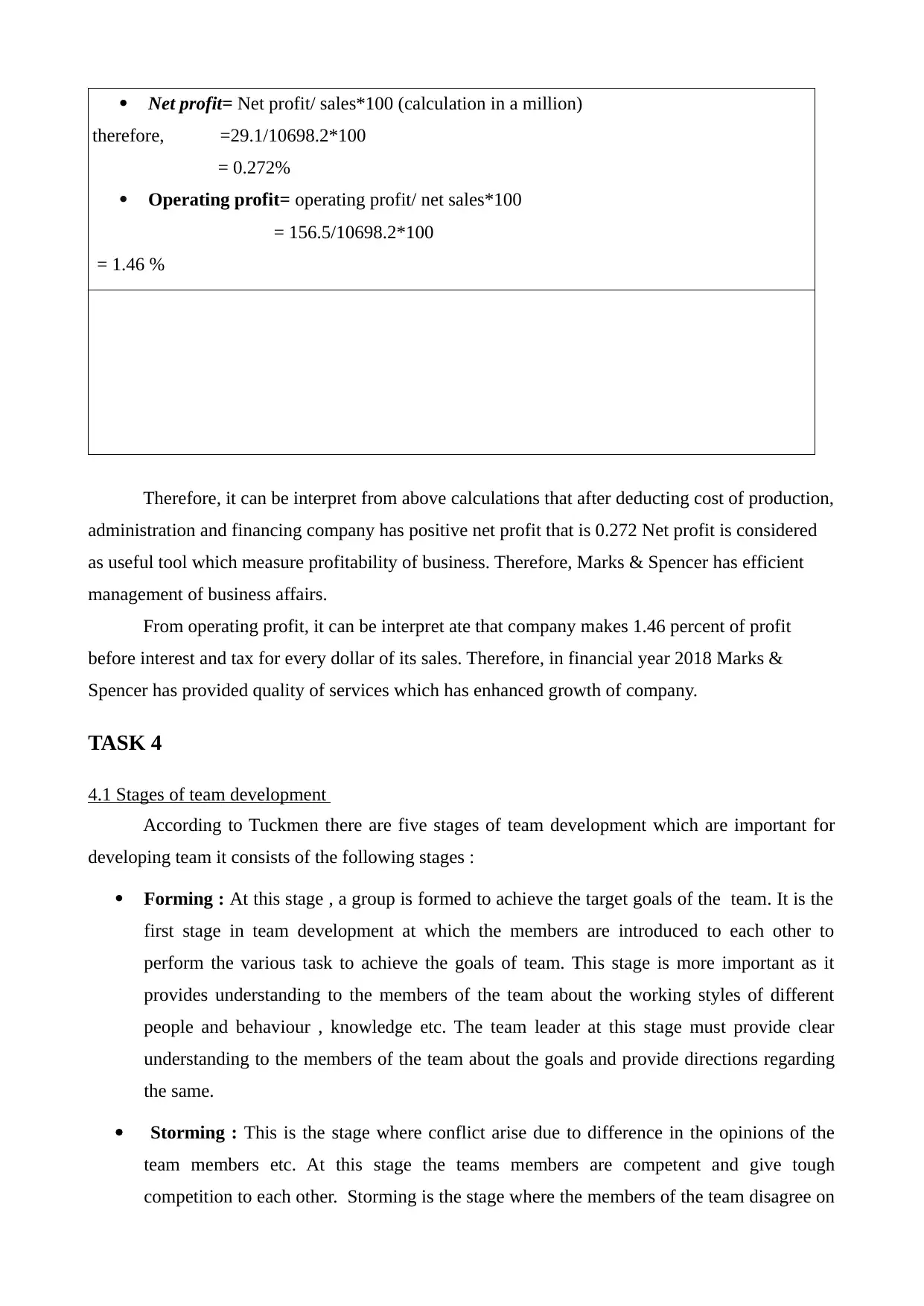
Net profit= Net profit/ sales*100 (calculation in a million)
therefore, =29.1/10698.2*100
= 0.272%
Operating profit= operating profit/ net sales*100
= 156.5/10698.2*100
= 1.46 %
Therefore, it can be interpret from above calculations that after deducting cost of production,
administration and financing company has positive net profit that is 0.272 Net profit is considered
as useful tool which measure profitability of business. Therefore, Marks & Spencer has efficient
management of business affairs.
From operating profit, it can be interpret ate that company makes 1.46 percent of profit
before interest and tax for every dollar of its sales. Therefore, in financial year 2018 Marks &
Spencer has provided quality of services which has enhanced growth of company.
TASK 4
4.1 Stages of team development
According to Tuckmen there are five stages of team development which are important for
developing team it consists of the following stages :
Forming : At this stage , a group is formed to achieve the target goals of the team. It is the
first stage in team development at which the members are introduced to each other to
perform the various task to achieve the goals of team. This stage is more important as it
provides understanding to the members of the team about the working styles of different
people and behaviour , knowledge etc. The team leader at this stage must provide clear
understanding to the members of the team about the goals and provide directions regarding
the same.
Storming : This is the stage where conflict arise due to difference in the opinions of the
team members etc. At this stage the teams members are competent and give tough
competition to each other. Storming is the stage where the members of the team disagree on
therefore, =29.1/10698.2*100
= 0.272%
Operating profit= operating profit/ net sales*100
= 156.5/10698.2*100
= 1.46 %
Therefore, it can be interpret from above calculations that after deducting cost of production,
administration and financing company has positive net profit that is 0.272 Net profit is considered
as useful tool which measure profitability of business. Therefore, Marks & Spencer has efficient
management of business affairs.
From operating profit, it can be interpret ate that company makes 1.46 percent of profit
before interest and tax for every dollar of its sales. Therefore, in financial year 2018 Marks &
Spencer has provided quality of services which has enhanced growth of company.
TASK 4
4.1 Stages of team development
According to Tuckmen there are five stages of team development which are important for
developing team it consists of the following stages :
Forming : At this stage , a group is formed to achieve the target goals of the team. It is the
first stage in team development at which the members are introduced to each other to
perform the various task to achieve the goals of team. This stage is more important as it
provides understanding to the members of the team about the working styles of different
people and behaviour , knowledge etc. The team leader at this stage must provide clear
understanding to the members of the team about the goals and provide directions regarding
the same.
Storming : This is the stage where conflict arise due to difference in the opinions of the
team members etc. At this stage the teams members are competent and give tough
competition to each other. Storming is the stage where the members of the team disagree on
Paraphrase This Document
Need a fresh take? Get an instant paraphrase of this document with our AI Paraphraser
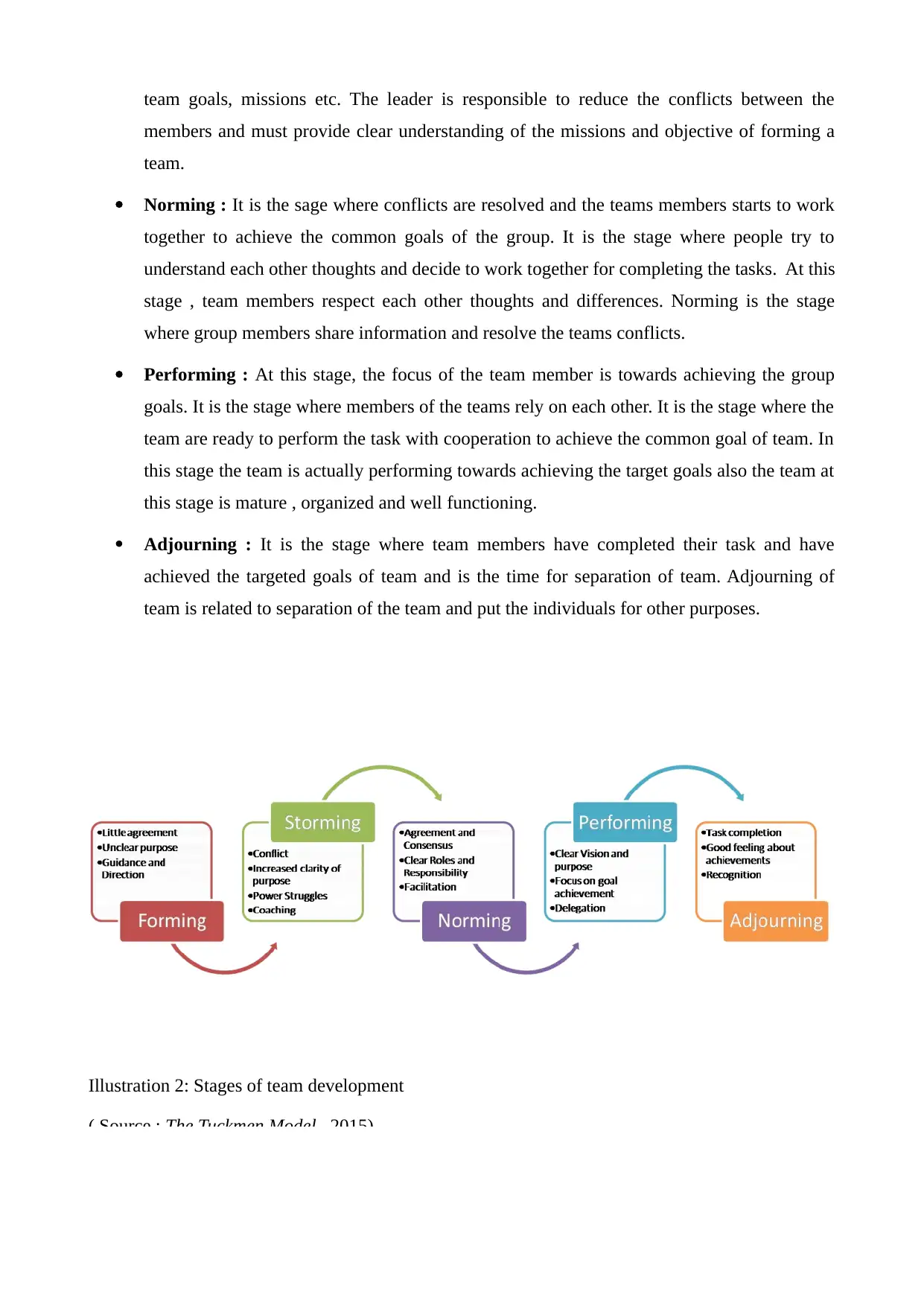
team goals, missions etc. The leader is responsible to reduce the conflicts between the
members and must provide clear understanding of the missions and objective of forming a
team.
Norming : It is the sage where conflicts are resolved and the teams members starts to work
together to achieve the common goals of the group. It is the stage where people try to
understand each other thoughts and decide to work together for completing the tasks. At this
stage , team members respect each other thoughts and differences. Norming is the stage
where group members share information and resolve the teams conflicts.
Performing : At this stage, the focus of the team member is towards achieving the group
goals. It is the stage where members of the teams rely on each other. It is the stage where the
team are ready to perform the task with cooperation to achieve the common goal of team. In
this stage the team is actually performing towards achieving the target goals also the team at
this stage is mature , organized and well functioning.
Adjourning : It is the stage where team members have completed their task and have
achieved the targeted goals of team and is the time for separation of team. Adjourning of
team is related to separation of the team and put the individuals for other purposes.
Illustration 2: Stages of team development
( Source : The Tuckmen Model , 2015)
members and must provide clear understanding of the missions and objective of forming a
team.
Norming : It is the sage where conflicts are resolved and the teams members starts to work
together to achieve the common goals of the group. It is the stage where people try to
understand each other thoughts and decide to work together for completing the tasks. At this
stage , team members respect each other thoughts and differences. Norming is the stage
where group members share information and resolve the teams conflicts.
Performing : At this stage, the focus of the team member is towards achieving the group
goals. It is the stage where members of the teams rely on each other. It is the stage where the
team are ready to perform the task with cooperation to achieve the common goal of team. In
this stage the team is actually performing towards achieving the target goals also the team at
this stage is mature , organized and well functioning.
Adjourning : It is the stage where team members have completed their task and have
achieved the targeted goals of team and is the time for separation of team. Adjourning of
team is related to separation of the team and put the individuals for other purposes.
Illustration 2: Stages of team development
( Source : The Tuckmen Model , 2015)
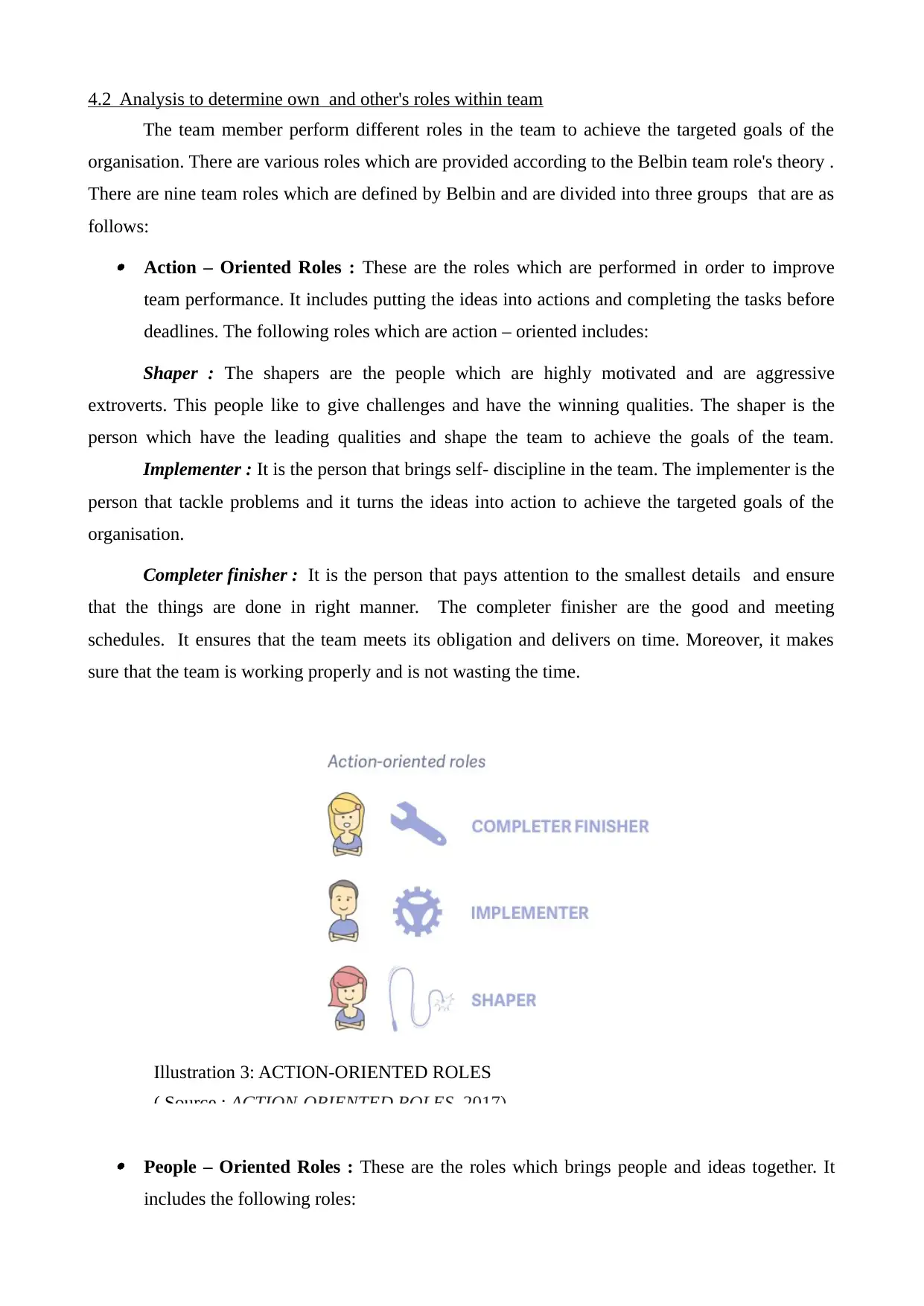
4.2 Analysis to determine own and other's roles within team
The team member perform different roles in the team to achieve the targeted goals of the
organisation. There are various roles which are provided according to the Belbin team role's theory .
There are nine team roles which are defined by Belbin and are divided into three groups that are as
follows:
Action – Oriented Roles : These are the roles which are performed in order to improve
team performance. It includes putting the ideas into actions and completing the tasks before
deadlines. The following roles which are action – oriented includes:
Shaper : The shapers are the people which are highly motivated and are aggressive
extroverts. This people like to give challenges and have the winning qualities. The shaper is the
person which have the leading qualities and shape the team to achieve the goals of the team.
Implementer : It is the person that brings self- discipline in the team. The implementer is the
person that tackle problems and it turns the ideas into action to achieve the targeted goals of the
organisation.
Completer finisher : It is the person that pays attention to the smallest details and ensure
that the things are done in right manner. The completer finisher are the good and meeting
schedules. It ensures that the team meets its obligation and delivers on time. Moreover, it makes
sure that the team is working properly and is not wasting the time.
People – Oriented Roles : These are the roles which brings people and ideas together. It
includes the following roles:
Illustration 3: ACTION-ORIENTED ROLES
( Source : ACTION-ORIENTED ROLES, 2017)
The team member perform different roles in the team to achieve the targeted goals of the
organisation. There are various roles which are provided according to the Belbin team role's theory .
There are nine team roles which are defined by Belbin and are divided into three groups that are as
follows:
Action – Oriented Roles : These are the roles which are performed in order to improve
team performance. It includes putting the ideas into actions and completing the tasks before
deadlines. The following roles which are action – oriented includes:
Shaper : The shapers are the people which are highly motivated and are aggressive
extroverts. This people like to give challenges and have the winning qualities. The shaper is the
person which have the leading qualities and shape the team to achieve the goals of the team.
Implementer : It is the person that brings self- discipline in the team. The implementer is the
person that tackle problems and it turns the ideas into action to achieve the targeted goals of the
organisation.
Completer finisher : It is the person that pays attention to the smallest details and ensure
that the things are done in right manner. The completer finisher are the good and meeting
schedules. It ensures that the team meets its obligation and delivers on time. Moreover, it makes
sure that the team is working properly and is not wasting the time.
People – Oriented Roles : These are the roles which brings people and ideas together. It
includes the following roles:
Illustration 3: ACTION-ORIENTED ROLES
( Source : ACTION-ORIENTED ROLES, 2017)
⊘ This is a preview!⊘
Do you want full access?
Subscribe today to unlock all pages.

Trusted by 1+ million students worldwide
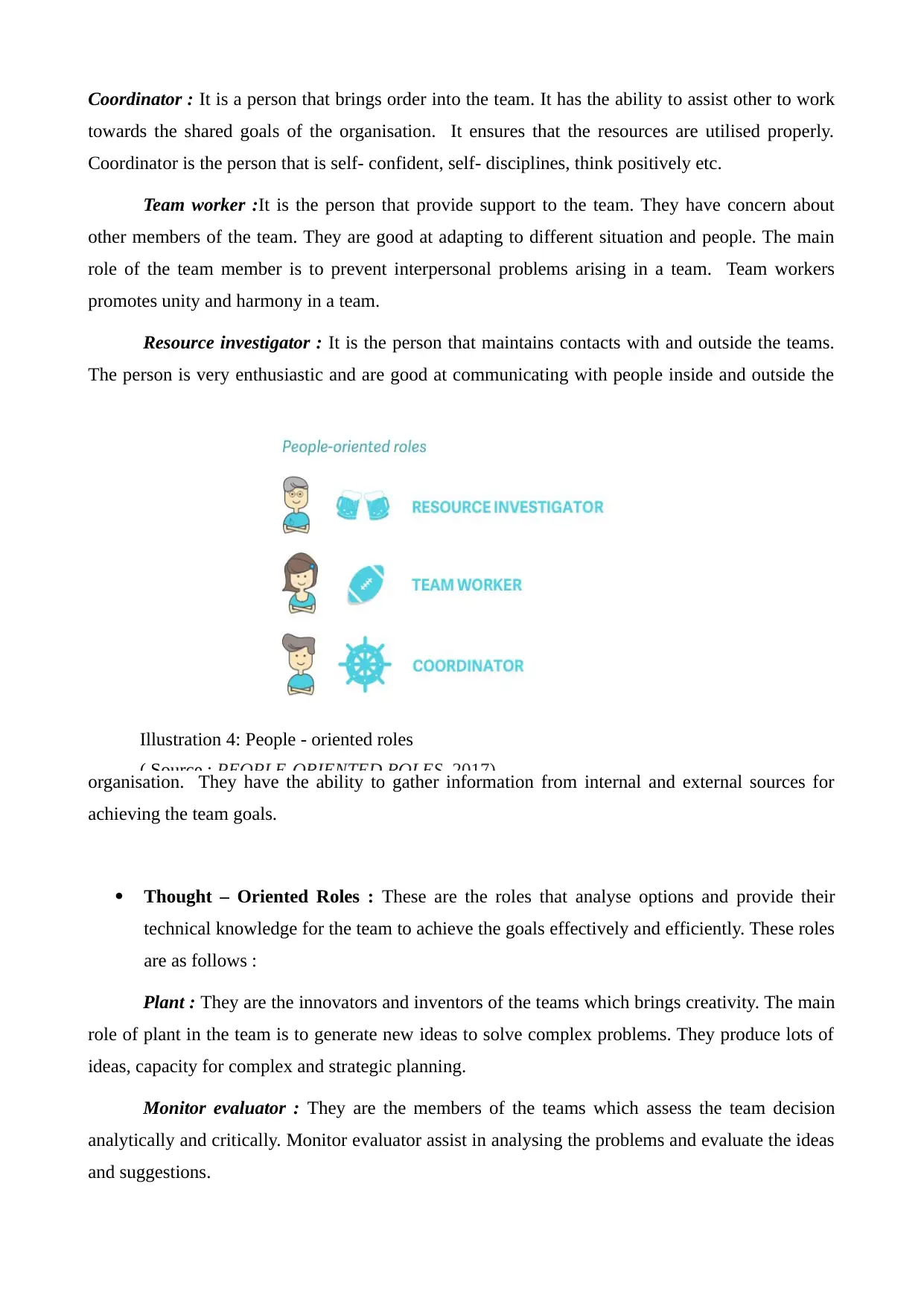
Coordinator : It is a person that brings order into the team. It has the ability to assist other to work
towards the shared goals of the organisation. It ensures that the resources are utilised properly.
Coordinator is the person that is self- confident, self- disciplines, think positively etc.
Team worker :It is the person that provide support to the team. They have concern about
other members of the team. They are good at adapting to different situation and people. The main
role of the team member is to prevent interpersonal problems arising in a team. Team workers
promotes unity and harmony in a team.
Resource investigator : It is the person that maintains contacts with and outside the teams.
The person is very enthusiastic and are good at communicating with people inside and outside the
organisation. They have the ability to gather information from internal and external sources for
achieving the team goals.
Thought – Oriented Roles : These are the roles that analyse options and provide their
technical knowledge for the team to achieve the goals effectively and efficiently. These roles
are as follows :
Plant : They are the innovators and inventors of the teams which brings creativity. The main
role of plant in the team is to generate new ideas to solve complex problems. They produce lots of
ideas, capacity for complex and strategic planning.
Monitor evaluator : They are the members of the teams which assess the team decision
analytically and critically. Monitor evaluator assist in analysing the problems and evaluate the ideas
and suggestions.
Illustration 4: People - oriented roles
( Source : PEOPLE-ORIENTED ROLES, 2017)
towards the shared goals of the organisation. It ensures that the resources are utilised properly.
Coordinator is the person that is self- confident, self- disciplines, think positively etc.
Team worker :It is the person that provide support to the team. They have concern about
other members of the team. They are good at adapting to different situation and people. The main
role of the team member is to prevent interpersonal problems arising in a team. Team workers
promotes unity and harmony in a team.
Resource investigator : It is the person that maintains contacts with and outside the teams.
The person is very enthusiastic and are good at communicating with people inside and outside the
organisation. They have the ability to gather information from internal and external sources for
achieving the team goals.
Thought – Oriented Roles : These are the roles that analyse options and provide their
technical knowledge for the team to achieve the goals effectively and efficiently. These roles
are as follows :
Plant : They are the innovators and inventors of the teams which brings creativity. The main
role of plant in the team is to generate new ideas to solve complex problems. They produce lots of
ideas, capacity for complex and strategic planning.
Monitor evaluator : They are the members of the teams which assess the team decision
analytically and critically. Monitor evaluator assist in analysing the problems and evaluate the ideas
and suggestions.
Illustration 4: People - oriented roles
( Source : PEOPLE-ORIENTED ROLES, 2017)
Paraphrase This Document
Need a fresh take? Get an instant paraphrase of this document with our AI Paraphraser
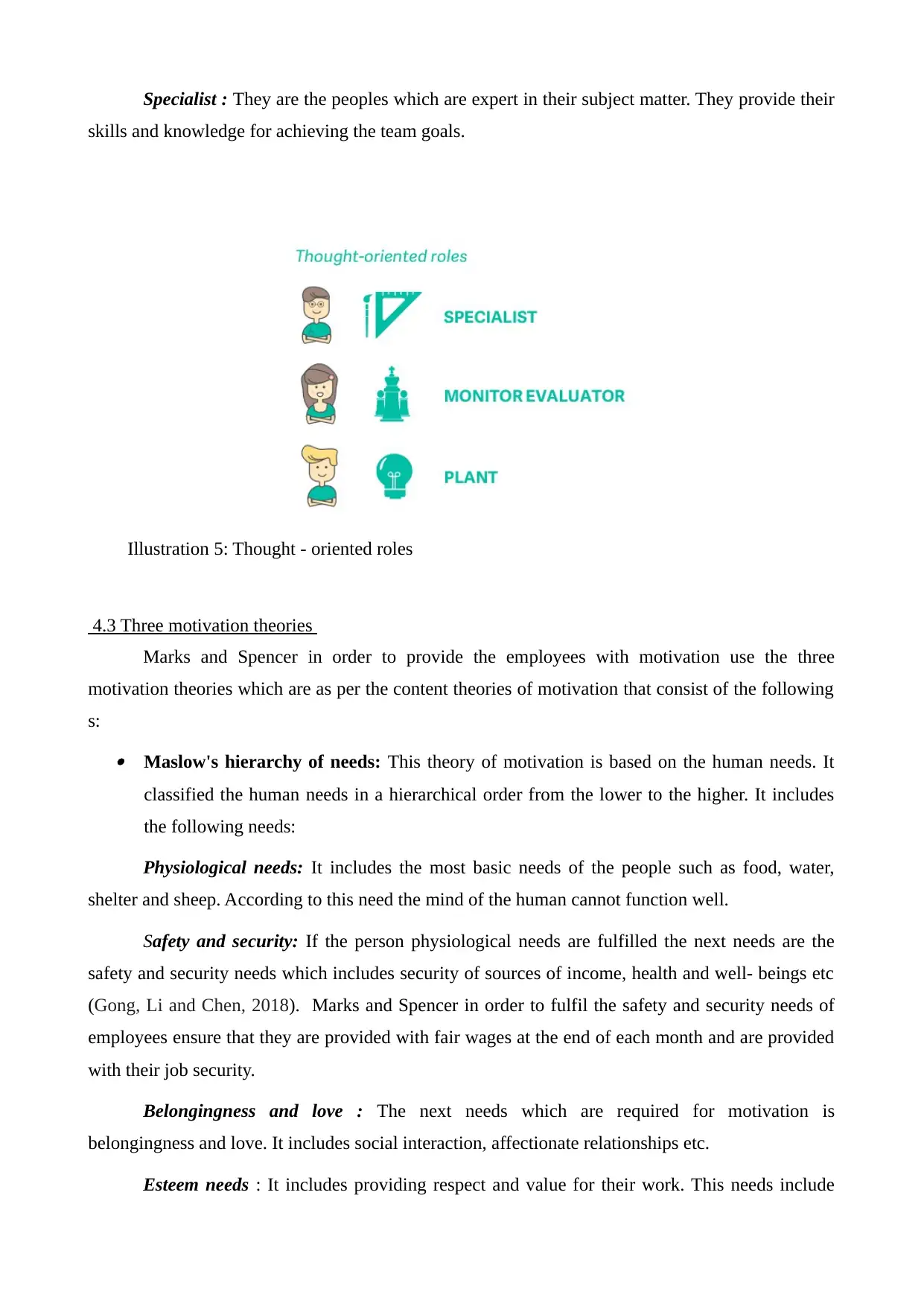
Specialist : They are the peoples which are expert in their subject matter. They provide their
skills and knowledge for achieving the team goals.
4.3 Three motivation theories
Marks and Spencer in order to provide the employees with motivation use the three
motivation theories which are as per the content theories of motivation that consist of the following
s: Maslow's hierarchy of needs: This theory of motivation is based on the human needs. It
classified the human needs in a hierarchical order from the lower to the higher. It includes
the following needs:
Physiological needs: It includes the most basic needs of the people such as food, water,
shelter and sheep. According to this need the mind of the human cannot function well.
Safety and security: If the person physiological needs are fulfilled the next needs are the
safety and security needs which includes security of sources of income, health and well- beings etc
(Gong, Li and Chen, 2018). Marks and Spencer in order to fulfil the safety and security needs of
employees ensure that they are provided with fair wages at the end of each month and are provided
with their job security.
Belongingness and love : The next needs which are required for motivation is
belongingness and love. It includes social interaction, affectionate relationships etc.
Esteem needs : It includes providing respect and value for their work. This needs include
Illustration 5: Thought - oriented roles
skills and knowledge for achieving the team goals.
4.3 Three motivation theories
Marks and Spencer in order to provide the employees with motivation use the three
motivation theories which are as per the content theories of motivation that consist of the following
s: Maslow's hierarchy of needs: This theory of motivation is based on the human needs. It
classified the human needs in a hierarchical order from the lower to the higher. It includes
the following needs:
Physiological needs: It includes the most basic needs of the people such as food, water,
shelter and sheep. According to this need the mind of the human cannot function well.
Safety and security: If the person physiological needs are fulfilled the next needs are the
safety and security needs which includes security of sources of income, health and well- beings etc
(Gong, Li and Chen, 2018). Marks and Spencer in order to fulfil the safety and security needs of
employees ensure that they are provided with fair wages at the end of each month and are provided
with their job security.
Belongingness and love : The next needs which are required for motivation is
belongingness and love. It includes social interaction, affectionate relationships etc.
Esteem needs : It includes providing respect and value for their work. This needs include
Illustration 5: Thought - oriented roles
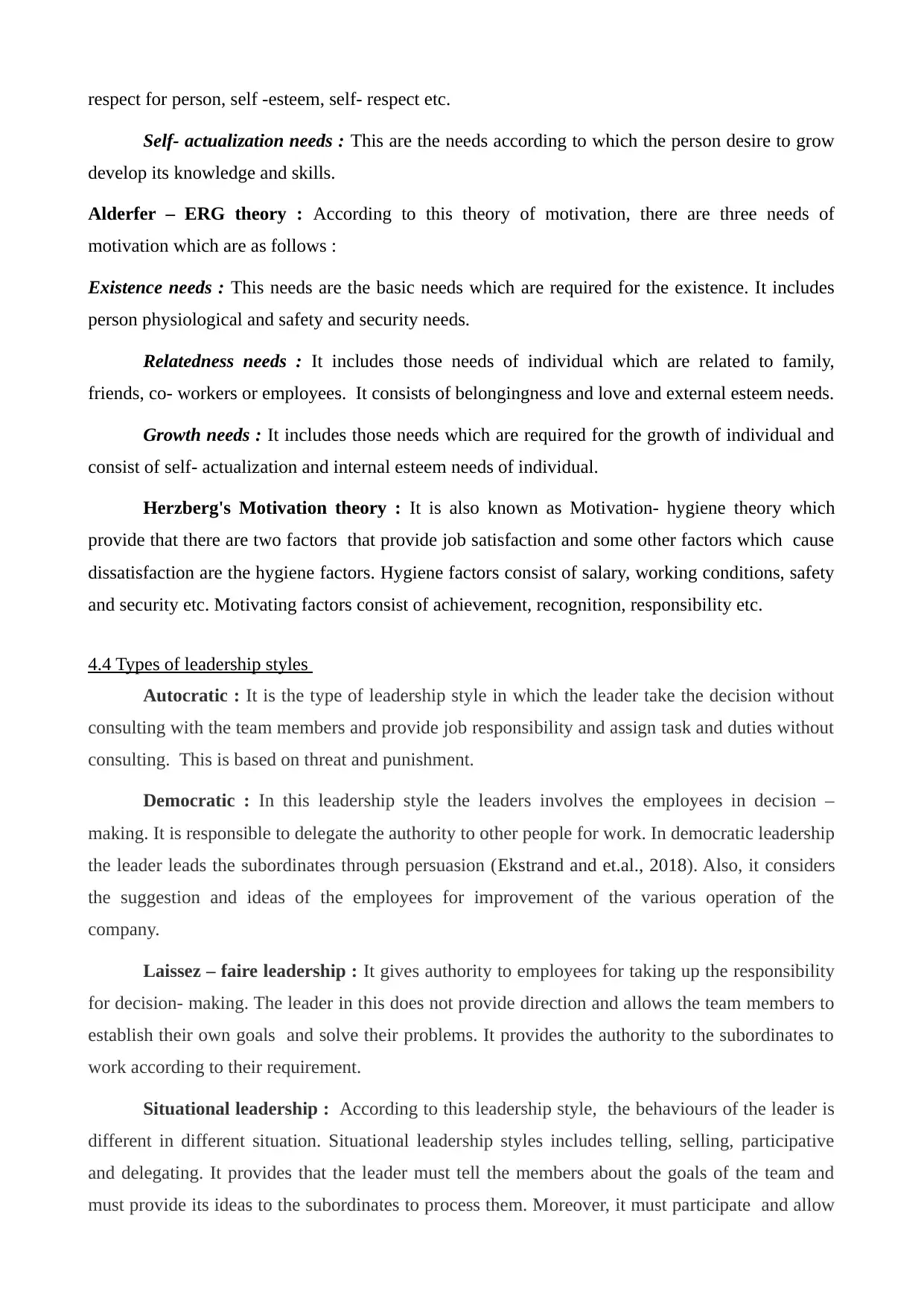
respect for person, self -esteem, self- respect etc.
Self- actualization needs : This are the needs according to which the person desire to grow
develop its knowledge and skills.
Alderfer – ERG theory : According to this theory of motivation, there are three needs of
motivation which are as follows :
Existence needs : This needs are the basic needs which are required for the existence. It includes
person physiological and safety and security needs.
Relatedness needs : It includes those needs of individual which are related to family,
friends, co- workers or employees. It consists of belongingness and love and external esteem needs.
Growth needs : It includes those needs which are required for the growth of individual and
consist of self- actualization and internal esteem needs of individual.
Herzberg's Motivation theory : It is also known as Motivation- hygiene theory which
provide that there are two factors that provide job satisfaction and some other factors which cause
dissatisfaction are the hygiene factors. Hygiene factors consist of salary, working conditions, safety
and security etc. Motivating factors consist of achievement, recognition, responsibility etc.
4.4 Types of leadership styles
Autocratic : It is the type of leadership style in which the leader take the decision without
consulting with the team members and provide job responsibility and assign task and duties without
consulting. This is based on threat and punishment.
Democratic : In this leadership style the leaders involves the employees in decision –
making. It is responsible to delegate the authority to other people for work. In democratic leadership
the leader leads the subordinates through persuasion (Ekstrand and et.al., 2018). Also, it considers
the suggestion and ideas of the employees for improvement of the various operation of the
company.
Laissez – faire leadership : It gives authority to employees for taking up the responsibility
for decision- making. The leader in this does not provide direction and allows the team members to
establish their own goals and solve their problems. It provides the authority to the subordinates to
work according to their requirement.
Situational leadership : According to this leadership style, the behaviours of the leader is
different in different situation. Situational leadership styles includes telling, selling, participative
and delegating. It provides that the leader must tell the members about the goals of the team and
must provide its ideas to the subordinates to process them. Moreover, it must participate and allow
Self- actualization needs : This are the needs according to which the person desire to grow
develop its knowledge and skills.
Alderfer – ERG theory : According to this theory of motivation, there are three needs of
motivation which are as follows :
Existence needs : This needs are the basic needs which are required for the existence. It includes
person physiological and safety and security needs.
Relatedness needs : It includes those needs of individual which are related to family,
friends, co- workers or employees. It consists of belongingness and love and external esteem needs.
Growth needs : It includes those needs which are required for the growth of individual and
consist of self- actualization and internal esteem needs of individual.
Herzberg's Motivation theory : It is also known as Motivation- hygiene theory which
provide that there are two factors that provide job satisfaction and some other factors which cause
dissatisfaction are the hygiene factors. Hygiene factors consist of salary, working conditions, safety
and security etc. Motivating factors consist of achievement, recognition, responsibility etc.
4.4 Types of leadership styles
Autocratic : It is the type of leadership style in which the leader take the decision without
consulting with the team members and provide job responsibility and assign task and duties without
consulting. This is based on threat and punishment.
Democratic : In this leadership style the leaders involves the employees in decision –
making. It is responsible to delegate the authority to other people for work. In democratic leadership
the leader leads the subordinates through persuasion (Ekstrand and et.al., 2018). Also, it considers
the suggestion and ideas of the employees for improvement of the various operation of the
company.
Laissez – faire leadership : It gives authority to employees for taking up the responsibility
for decision- making. The leader in this does not provide direction and allows the team members to
establish their own goals and solve their problems. It provides the authority to the subordinates to
work according to their requirement.
Situational leadership : According to this leadership style, the behaviours of the leader is
different in different situation. Situational leadership styles includes telling, selling, participative
and delegating. It provides that the leader must tell the members about the goals of the team and
must provide its ideas to the subordinates to process them. Moreover, it must participate and allow
⊘ This is a preview!⊘
Do you want full access?
Subscribe today to unlock all pages.

Trusted by 1+ million students worldwide
1 out of 15
Related Documents
Your All-in-One AI-Powered Toolkit for Academic Success.
+13062052269
info@desklib.com
Available 24*7 on WhatsApp / Email
![[object Object]](/_next/static/media/star-bottom.7253800d.svg)
Unlock your academic potential
Copyright © 2020–2025 A2Z Services. All Rights Reserved. Developed and managed by ZUCOL.





